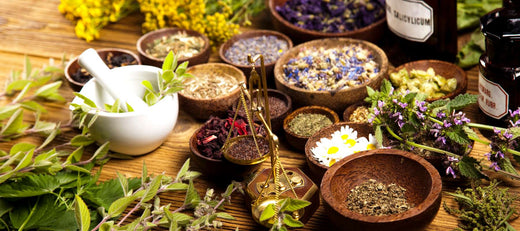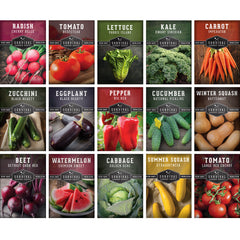When planning your survival garden, you should think about planting helpful herbs - not just for seasoning your food, but also for their many medicinal benefits. Some herbs have been used for centuries to heal wounds, soothe illnesses, and relieve stress and anxiety.
Here are 10 herbs we think should be in everyone’s survival garden. Many of these herbs also do great in containers, so they can be grown indoors or on a patio if you don’t have a large gardening space.
Calendula

Calendula, also known as pot marigold, has been used for medicinal purposes since at least the 12th century. Calendula flowers have anti-inflammatory properties and are often used in topical oils and salves for healing wounds, rashes, burns, diaper rash, and dry skin. Calendula can also be used in teas and tinctures taken internally to soothe acid reflux and ulcers.
As its nickname would indicate, Calendula does well growing in pots. The double orange blossoms on this plant make beautiful cut flowers.
Chamomile
Chamomile is one of the most popular medicinal herbs in the Western World. It has been used as a medicine going back to the ancient Egyptians. Historically, chamomile has been used for skin conditions, stomach problems, and mild infections. It has anti-inflammatory and antiseptic properties. Currently, most people use chamomile in tea to relieve anxiety and help them sleep. It is also popular for soothing stomach issues.
Chamomile is a low-growing perennial ground cover that spreads via rhizomes. It is durable enough to handle light foot traffic and its blooms will attract pollinators.
Dill

Dill is a seed crop herb that has been cultivated for more than 2000 years. The seeds are a popular therapeutic for digestive issues. Dill seed oil is an important part of gripe water, an over-the-counter remedy including sodium bicarbonate and other herbs used to soothe colic in babies. Dill seeds and leaves have been used to care for bruises and gum infections. Dill is high in vitamin C so it was also used for scurvy. It has anti-fungal properties that help food preservation.
Dill grows as a feathery bush that can reach 3 to 5 feet tall. Its leaves and seeds can be harvested and used fresh or dried.
Echinacea
Echinacea is also known as Purple Coneflower. It is a Native American medicinal plant that has been used for more than 400 years to attend to infections and wounds. Throughout history, it has been used for scarlet fever, syphilis, diphtheria, and more. Today most people use Echinacea to shorten the duration and reduce the symptoms of the common cold and flu. Studies suggest that echinacea contains active compounds that boost the immune system, reduce pain and inflammation, and may have antiviral effects. The roots, seeds, and flowers of echinacea all have medicinal properties.
Purple Coneflower is a very easy to grow herbaceous perennial that enjoys full sun and produces beautiful purple flowers that pollinators love.
Holy Basil

Holy Basil, also known as Tulsi, is called the Queen of Herbs in its native Southeast Asia. The entire plant, from leaves to seeds, has historically been used for many conditions from eye diseases to ringworm. Tulsi’s licorice-scented leaves make a tasty herbal tea and are highly aromatic and anti-microbial. It is an adaptogen that helps to promote energy, mental clarity, and focus.
Holy basil grows well indoors and should be pruned frequently to encourage bushiness and a prolonged harvest.
Lavender
The soothing scent of lavender is widely known. Lavender has been studied for its benefits in helping with anxiety, depression, and insomnia. It is also being studied for its anti-bacterial and anti-viral properties. In folklore, pillows were filled with lavender flowers to help people fall asleep. Scientific evidence suggests that lavender may slow the activity of the nervous system and promote better sleep and relaxation.
Lavender is a perennial shrub that is drought-tolerant and deer resistant.
Lemon Balm

Lemon Balm is a member of the mint family and is another herb that has historically been used as far back as the Middle Ages to reduce stress, and anxiety, and promote sleep. It is also known to provide relief from indigestion and colic in babies. There are some studies that indicate Lemon Balm may also have anti-bacterial properties, too.
Because Lemon Balm is a member of the mint family, it is best contained in a large pot rather than planted in a garden bed.
Oregano
While we all know oregano for the flavor it adds to our food, it has several important health benefits as well. Oregano is rich in antioxidants, making it useful in helping to prevent damage by free radicals in the body that have been associated with chronic conditions like heart disease. Those antioxidants can help relieve muscle pain and joint pain associated with arthritis. It is also suspected to have anti-viral and anti-microbial properties.
Oregano is a perennial herb that spreads easily. It works well in containers.
Peppermint
Peppermint and peppermint oil are popular as flavoring, but the herb has many medicinal uses as well. When brewed as a tea, it has been used for soothing stomach issues, headaches, and morning sickness. Studies suggest that peppermint oil can help calm the symptoms of Irritable Bowel Syndrome. It can also be used topically for cooling the skin and calming skin irritation.
Peppermint is very easy to grow, and can easily take over a garden bed. We recommend you grow it in large pots so that the plant is contained.
Yarrow

The Latin name of Yarrow is “Achilles Millefolium”. Legend has it that the mythical Greek hero Achilles covered his body with a tincture of yarrow to protect him in battle. However, he missed his heel leaving that area vulnerable, which is where the term “Achilles heel” comes from. Yarrow was popular in European folk medicine for the alleviation of indigestion. It is commonly applied to wounds to stop bleeding. This is done by crushing yarrow leaves and flowers into a paste and applying it as a poultice. It can also be taken internally to help relieve menstrual cramps.
Yarrow is a perennial herb that produces clusters of tiny flowers that are attractive to pollinators. It is drought tolerant and thrives in poor soil with very little maintenance.
When planning a survival garden, the use of medicinal herbs is a must. Not only do they serve the dual purpose of adding flavor to cooking and having useful therapeutic properties, but they are also easy to grow and adaptable to many growing conditions.
Disclaimer: The statements above have not been evaluated by the Food and Drug Administration. These products are not intended to diagnose, treat, cure, or prevent any disease.
























